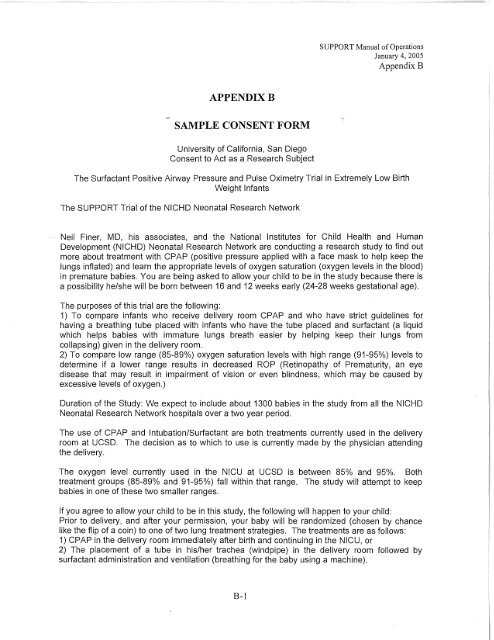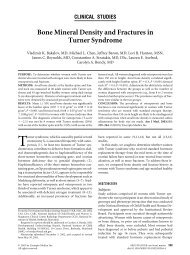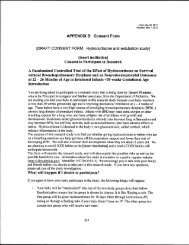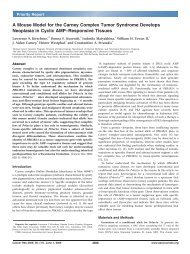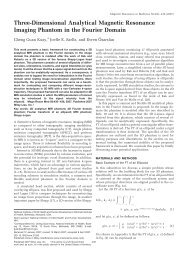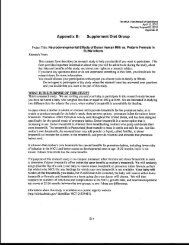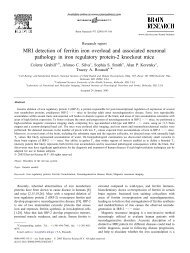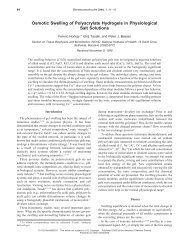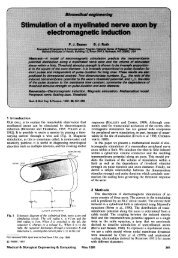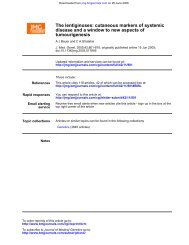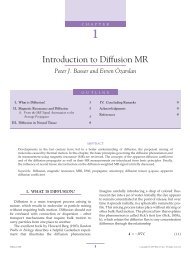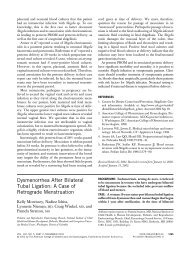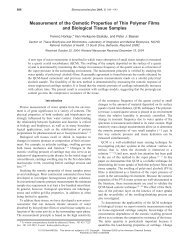Appendix B Sample Consent Form (NICHD)
Appendix B Sample Consent Form (NICHD)
Appendix B Sample Consent Form (NICHD)
Create successful ePaper yourself
Turn your PDF publications into a flip-book with our unique Google optimized e-Paper software.
SUPPORT Manual of Operations<br />
January 4, 2005<br />
<strong>Appendix</strong> B<br />
APPENDIXB<br />
SAMPLE CONSENT FORM<br />
University of California, San Diego <br />
<strong>Consent</strong> to Act as a Research Subject <br />
The Surfactant Positive Airway Pressure and Pulse Oximetry Trial in Extremely Low Birth <br />
Weight Infants <br />
The SUPPORT Trial of the <strong>NICHD</strong> Neonatal Research Network <br />
Neil Finer, MD, his associates, and the National Institutes for Child Health and Human <br />
Development (<strong>NICHD</strong>) Neonatal Research Network are conducting a research study to find out <br />
more about treatment with CPAP (positive pressure applied with a face mask to help keep the <br />
lungs inflated) and learn the appropriate levels of oxygen saturation (oxygen levels in the blood) <br />
in premature babies. You are being asked to allow your child to be in the study because there is <br />
a possibility he/she will be born between 16 and 12 weeks early (24-28 weeks gestational age). <br />
The purposes of this trial are the following: <br />
1) To compare infants who receive delivery room CPAP and who have strict guidelines for <br />
having a breathing tube placed with infants who have the tube placed and surfactant (a liquid <br />
which helps babies with immature lungs breath easier by helping keep their lungs from <br />
collapsing) given in the delivery room. <br />
2) To compare low range (85-89%) oxygen saturation levels with high range (91-95%) levels to <br />
determine if a lower range results in decreased ROP (Retinopathy of Prematurity, an eye <br />
disease that may result in impairment of vision or even blindness, which may be caused by <br />
excessive levels of oxygen.) <br />
Duration of the Study: We expect to include about 1300 babies in the study from all the <strong>NICHD</strong> <br />
Neonatal Research Network hospitals over a two year period. <br />
The use of CPAP and Intubation/Surfactant are both treatments currently used in the delivery <br />
room at UCSD. The decision as to which to use is currently made by the physician attending <br />
the delivery. <br />
The oxygen level currently used in the NICU at UCSD is between 85% and 95%. Both <br />
treatment groups (85-89% and 91-95%) fall within that range. The study will attempt to keep <br />
babies in one of these two smaller ranges. <br />
If you agree to allow your child to be in this study, the following will happen to your child: <br />
Prior to delivery, and after your permission, your baby will be randomized (chosen by chance <br />
like the flip of a coin) to one of two lung treatment strategies. The treatments are as follows: <br />
1) CPAP in the delivery room immediately after birth and continuing in the NICU, or <br />
2) The placement of a tube in his/her trachea (windpipe) in the delivery room followed by <br />
surfactant administration and ventilation (breathing for the baby using a machine). <br />
B-1
SUPPORT Manual of Operations<br />
January 4, 2005<br />
<strong>Appendix</strong> B<br />
In addition to being randomly assigned to one of the two groups described above, your baby will<br />
be randomized to a High reading or Low reading oximeter (a monitor that displays how much<br />
oxygen is in the blood). The oximeters (oxygen monitors) used in this trial are FDA approved<br />
oximeters which have bee,!:) modified for research purposes. This m()dification makes the<br />
monitors show a value which is either slightly higher or slightly lower thanthe true oxygen level<br />
when values are between 85 and 95%. Outside those ranges, the oximeter works the same as<br />
the standard of care device.<br />
Which group your baby is randomized to will not be known to the nurse taking care of your baby,<br />
or his/her physician. Only the study coordinator will know which group your baby is in. Within the<br />
range of oxygen which we normally keep babies in, your baby will either be on the high end of<br />
normal or the low end of normal. He/she will remain on this device until he/she reaches 36 weeks<br />
adjusted age. (e. g. 24 wks gestation plus 12 weeks of age = 36 weeks adjusted age). Other care<br />
will be conducted as normal during his/her participation in the study. Your baby will be followed in<br />
our Infant Follow-up clinic at 6 and 12 months as standard of care for small babies. At 18-22<br />
months corrected age your baby will receive, at no charge to you, a complete exam of their<br />
muscles, nerves, and mental and coordinated movement skills.<br />
Participation in this study may involve some added risks or discomforts. Because all of the<br />
treatments proposed in this study are standard of care, there is no predictable increase in risk<br />
for your baby. Infants randomized to the CPAP group may, at some point in their care, require<br />
intubation and assisted ventilation (methods to help them breathe). If the attending physician<br />
deems this necessary, participation in the study will not affect this decision. Some unknown risks<br />
may be learned during the study. If these occur, you will be informed by the study personnel.<br />
The only other risk of this study is the risk to confidentiality. Every effort will be made to keep<br />
your child's medical record confidential. There will be no name or other patient identification in<br />
any study report that may be published after the study is completed. Measures taken to protect<br />
you and your baby's identity are described in the confidentiality section of this document.<br />
There may be benefits to your child directly, including a possible decrease in chronic lung<br />
disease (need for extra oxygen near discharge) and/or a decrease in the need for eye surgery<br />
as a result of exposure to oxygen. Because we do not know in advance the actual strategies<br />
chosen for your child, or which of the treatment strategies is the most effective, it is also<br />
possible that your baby will receive no direct benefit. The knowledge learned from this study<br />
may help us treat babies in the future. However, as noted above, each of the 4 possible<br />
combinations of treatments is considered by some units to represent their desired approach.<br />
If your child is injured as a direct result of participation in this research, the University of<br />
California will provide any medical care your child needs to treat those injuries. The University<br />
will not provide any other form of compensation to you if your child is injured. You may call the<br />
UCSD Human Research Protections Program office at (858) 455-5050 for more information<br />
about this, or to inquire about your rights as a research subject, or to report research-related<br />
problems.<br />
_______ has explained this study to you and answered your questions. If you have<br />
other questions or research-related problems, you may reach Wade Rich, the Study<br />
Coordinator, or Renee Bridge, the Research Nurse, at 619-543-6560. You may contact the<br />
principal investigator Dr. Neil Finer at 619-543-3794<br />
B-2
SUPPORT Manual of Operations<br />
January 4, 2005<br />
<strong>Appendix</strong> B<br />
As an alternative to participation in this study you may decide to have your baby's doctor decide<br />
which treatment your baby will receive. If you decide not to include your child in this study, none<br />
of his/her medical information will be included in the study data. Participation in research is<br />
entirely voluntary. You may refuse to participate or withdraw at any time without jeopardy to the<br />
medical care your child will receive at this institution of other loss of benefits to which your child<br />
is entitled. If you withdraw your child from the study, the attending physician will decide whether<br />
to maintain current treatment or change it, based on your child's needs at the time of the<br />
decision. Data collection for research purposes will stop at that time.<br />
Clinical information will be collected from your baby's chart by study personnel at UCSD.<br />
Information will be labeled with a code number. Coded information will be sent to the <strong>NICHD</strong><br />
Neonatal Network's Data Collection Center at Research Triangle Institute (RTI) in Research<br />
Triangle Park, North Carolina. The study log linking the code number with your baby's identity<br />
will be kept under lock and key at UCSD. Information directly identifying your baby will not leave<br />
UCSD. Research records will be kept confidential to the extent provided by law.<br />
You may withdraw your child from the study for any reason. In addition, the study doctors may<br />
decide to withdraw your child if they feel it is in his/her best interest to do so.<br />
You have received a copy of this consent document to keep and the Experimental Subject's Bill<br />
of Rights<br />
You agree to have your child participate.<br />
Parent's or legal guardian's signature<br />
DATE<br />
Relationship of legal guardian to subject<br />
DATE<br />
Signature of person explaining and getting consent<br />
DATE<br />
B-3


